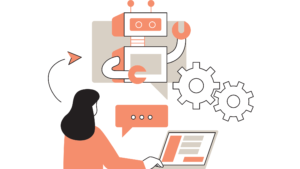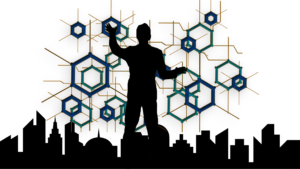Mobile devices have become an extension of our lives because they keep us connected, entertained, and productive wherever we go. With the increasing usage of smartphones, mobile apps have become more of a necessity than a luxury. But in a world where users have endless choices, simply having a functional app isn’t enough. With the changing times, people expect seamless interactions, stunning visuals, and a natural and engaging experience. That’s why UI design is constantly evolving. In 2025, mobile app interfaces will be smarter, more adaptive, and visually immersive.
From AI-driven personalization that tailors experiences to individual users to gesture-based navigation that makes interactions feel effortless, the future of UI is all about making apps feel more intuitive. At the same time, design enhancements like glassmorphism, motion UI, and microinteractions add a layer of sophistication that makes apps usable and delightful. This blog will guide you to the top UI trends shaping mobile apps in 2025, helping you understand the latest innovations and how to apply them.
Top Trends You Need to Follow
Mobile app UI trends in 2025 are all about delivering seamless, intuitive, and immersive user experiences. Here are some of the top trends shaping the future of mobile app UI:
1. AI-Powered Personalization
In 2025, apps will feel more personalized than ever. Using AI, they’ll learn your preferences and show you content, features, or suggestions that match your needs. Music apps might create playlists based on your listening habits, shopping apps might recommend products you’ll love, and AI in restaurants will enhance dining experiences by suggesting meals based on your taste preferences or past orders.
AI will also adapt the app’s layout and features based on how you use it, making everything feel tailored just for you. It’s all about creating a seamless and engaging experience so you spend less time searching and more time enjoying.
2. Neumorphism 2.0
Neumorphism is a design style that makes apps look soft and realistic, like they’re popping out of the screen. In 2025, this trend will evolve into Neumorphism 2.0, with smoother shadows, better contrasts, and a focus on simplicity. Designers will use this style to create buttons, cards, and icons that feel tactile and easy to interact with.
For example, a button might look like it’s slightly raised, making it clear where to tap. Neumorphism 2.0 will also work well with dark mode and adaptive themes, ensuring that the design looks great in any setting. It’s a modern and stylish approach to mobile app design, making apps look clean and professional while keeping them user-friendly.
3. Voice-Enabled UI (VUI)
Talking to your apps will become even more common in 2025. Instead of tapping buttons, you’ll use your voice to search, navigate, or control apps. You might ask your food delivery app to order your favorite meal or tell your calendar app to add an event. Voice-enabled UIs will also provide smart feedback, confirming requests or asking follow-up questions.
With advancements in mobile app development, this technology will be even more seamless and intuitive. It will be especially useful when you’re busy or on the go, like when driving and needing to send a message or find directions. It’s hands-free, quick, and convenient, making everyday tasks easier and more efficient.
4. Dark Mode and Adaptive Themes
Dark mode isn’t just trendy; it’s easy on your eyes and saves battery life. In 2025, apps will not only offer dark mode but also adapt their themes based on your preferences or the time of day. For example, the app might switch to dark mode at night or use brighter colors during the day. Some apps might even let you customize the theme to match your mood or style, like choosing a calming blue or a vibrant pink.
To enhance this experience, visualization tools will help users preview and fine-tune these adaptive themes in real time. Whether adjusting brightness, contrast, or color schemes, these tools will make customization more intuitive and user-friendly.
5. Microinteractions & Motion UI
Small animations and interactions will make apps feel alive and fun to use. For example, when you like a post, a little heart might pop up, or when you refresh a page, a smooth animation might play. These microinteractions give you instant feedback, making the app feel responsive and engaging. Motion UI design will also guide you through the app, showing you where to tap or swipe next.
For instance, a loading animation might entertain you while you wait, or a subtle bounce effect might confirm that your action was successful. These tiny details make using apps more enjoyable and help you understand how everything works, creating a seamless and delightful experience.
6. Inclusive and Accessible Design
Apps in 2025 will be designed for everyone, including people with disabilities. This means bigger buttons for easier tapping, screen readers for the visually impaired, and color schemes that work for colorblind users. Customizable settings, like adjustable text sizes and high-contrast modes, will make apps more user-friendly for different needs.
A banking app might include voice guidance for visually impaired users, while a social media app could add captions to videos for those with hearing difficulties. Inclusive design isn’t just about accessibility, it’s about ensuring everyone can use and enjoy the app, regardless of their abilities or preferences.
7. Glassmorphism & Frosted UI Elements
Glassmorphism is a sleek design trend that makes app elements look like frosted glass. By using blur effects and transparency, it creates a modern, layered aesthetic. In 2025, this style will give apps a fresh, clean, and visually striking feel. Menus or cards might feature semi-transparent backgrounds, allowing users to see what’s behind them while keeping the focus on the content.
It’s perfect for dashboards, notifications, or settings panels, where clarity meets elegance. Also, glassmorphism pairs beautifully with dark mode and vibrant colors, adding a stylish, futuristic vibe. It’s a great way to give your app a modern look without compromising on usability.
8. Gesture-Based Navigation
In 2025, apps will rely more on gestures like swiping, pinching, or tapping to navigate. Swiping left can delete an email, while pinching zooms into a photo. Gestures make interactions feel more natural and intuitive, especially on larger screens or foldable devices. Apps will also include subtle hints or tutorials to help users learn these gestures quickly.
A quick animation might demonstrate how to swipe to access a hidden menu or double-tap to like a post. Gesture-based navigation not only makes apps look cleaner but also enhances speed and usability, allowing users to focus on what matters.
The Future of Mobile UI is Smarter and Engaging
As mobile apps continue to evolve, UI design is becoming smarter, more intuitive, and visually engaging. Trends like AI-driven personalization, gesture-based navigation, and immersive animations are shaping how users interact with apps, making experiences smoother and more enjoyable.
At the same time, adaptability for foldable devices and wearables ensures apps stay future-ready. Staying ahead in 2025 means embracing these trends to create apps that are not just functional but truly engaging. Whether it’s through seamless navigation, dynamic visuals, or personalized experiences, the goal remains the same: delivering an app that users love to use.





